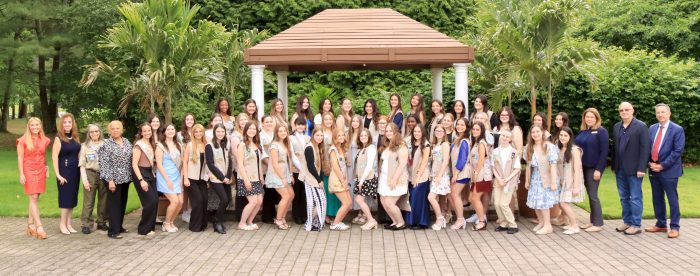The Girl Scouts of Suffolk County recently honored 55 Girl Scouts at its annual Gold Award Dinner & Ceremony on at the Stonebridge Country Club in Smithtown, for identifying an issue they care about and leading a team to create lasting impact in their communities—and beyond. The Gold Award is the most prestigious award in Girl Scouting.
Gold Award Girl Scouts address issues they’re passionate about by planning and implementing a project that produces lasting change in their communities and beyond. To earn a Gold Award, each recipient must complete two Senior or Ambassador Journeys or their Girl Scout Silver Award before beginning their Gold Award project. To meet the Girl Scout Gold Award requirements, each candidate must complete at least 80 hours toward their project.
“Our Gold Award Girl Scouts are leaders in their community who are making measurable and sustainable change while still in high school said Tammy Severino, President and CEO of Girl Scouts of Suffolk County. “As they take action to transform their world, they gain tangible, real-world skills and a civic-minded awareness that sets them apart from their peers. 96% of Gold Award Girl Scouts say their experience inspired their ongoing commitment to service or volunteering. Our Gold Award Girl Scouts are discovering they have the power to create the future they want for themselves and others, and we are proud and honored by their achievements.”
Among the awardees:
Sophia Aurrecoechea – Islip Terrace
Giuliana Avella – Port Jefferson Station
Sara Bally – Miller Place
Elliot Baravarian – East Northport
Emma Barbo – Greenlawn
Eva Barbo – Greenlawn
Gianna Beck – North Babylon
Madison Calvanese – Setauket
Isabella Caracci – Stony Brook
Molly Caufield – Sound Beach
Marissa Cilibrasi – Ronkonkoma
Megan Condolff – Centerport
Nina Cottone – Setauket
Ellie Crowley – Huntington
Ava D’Angelo – Commack
Olivia Davis – Patchogue
Alessandra De Stefano – Commack
Emma Dean-Stahl – West Sayville
Mya DeClue – Smithtown
Anna DiBiase – Smithtown
Alexis Ebanks – Centerport
Sophie Epstein – Nesconset
Charlotte Farrugia – Selden
Jasmine Farrugia – Selden
Jailyn Fasano – Commack
Lillian Fleischer – Centerport
Julia Furer – Dix Hills
Grace Goetz – Greenlawn
Kristin Krause – Nesconset
Kayden Laucella – Stony Brook
Lauren Limongelli – West Babylon
Olivia LoBue – Huntington
Ruth Joy Mahnken – Ridge
Callie McLean – Mattituck
Jenna Mehlinger – Smithtown
Gabrielle Mitchell – Nesconset
Isabella Muccio – Port Jefferson Station
Brianna Naumann – St. James
Danika Riccio – Bayshore
Paige Rizzo – West Babylon
Elizabeth Ryan – Medford
Regan Sayers – Smithtown
Lily Scarth – East Setauket
Nicole Schrock – Cold Spring Harbor
Adelina Scott – Westhampton
Caroline Severino – Nesconset
Kinley Simmons – Miller Place
Samantha Simson – Commack
Victoria Starkey – Smithtown
Emma Travaglia – West Sayville
Kristin Tveter – Bayport
Adria Vargas – Sayville
Olivia Vigliotti – Ronkonkoma
Amanda Woods – Bayport
Cassidy Yates – West Babylon
Details about each Girl Scout’s project were shared with the audience in a print and digital yearbook, here. A video about their achievements, also shared at the event, is here.
The event was memorialized online with a photo booth of fun photos, here.
About Girl Scouts of Suffolk County
Since 1968, Girl Scouts of Suffolk County has been committed to building girls of courage, confidence, and character who make the world a better place. With over 15,000 members, they are one of the largest youth-serving agencies in Suffolk County. Girl Scouts helps girls develop their full individual potential; relate to others with increasing understanding, skill, and respect; develop values to guide their actions and provide the foundation for sound decision making; and contribute to the improvement of society through their abilities, leadership skills, and cooperation with others. For more information about the Girl Scouts of Suffolk County, please call (631) 543-6622 or visit www.gssc.us. Follow Girl Scouts of Suffolk County onFacebook, X, Instagram, YouTube and LinkedIn.

























